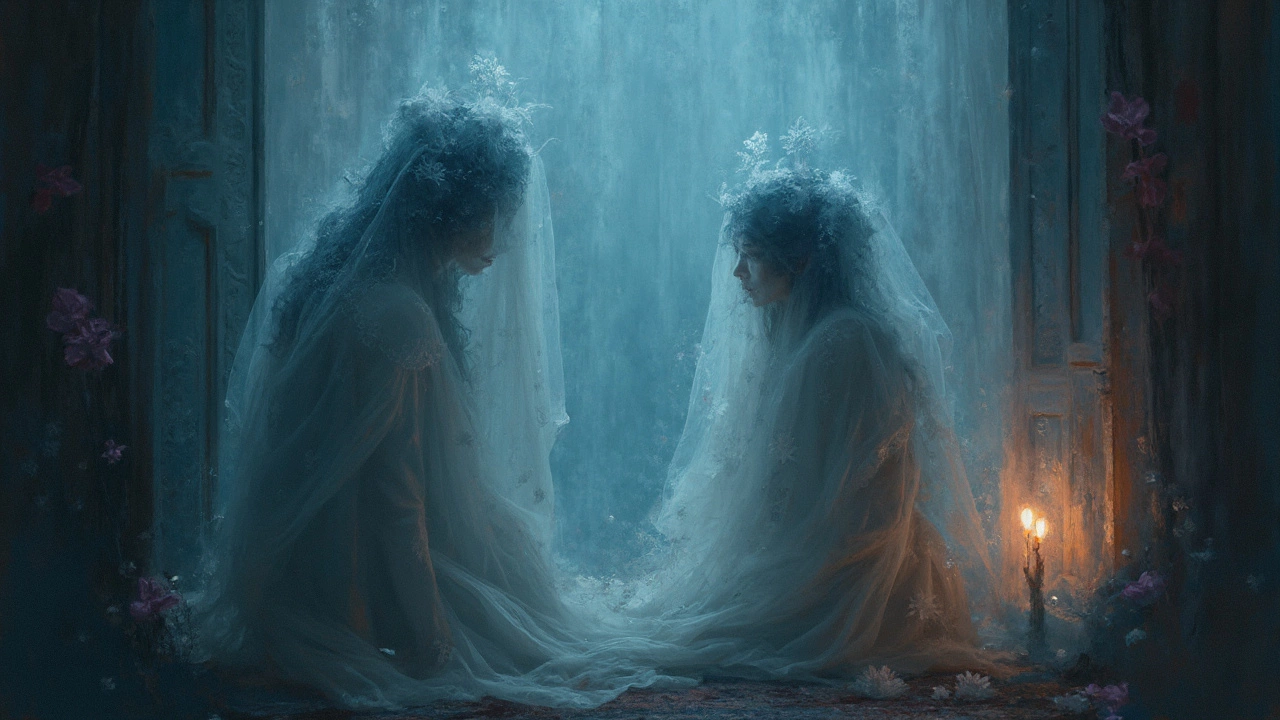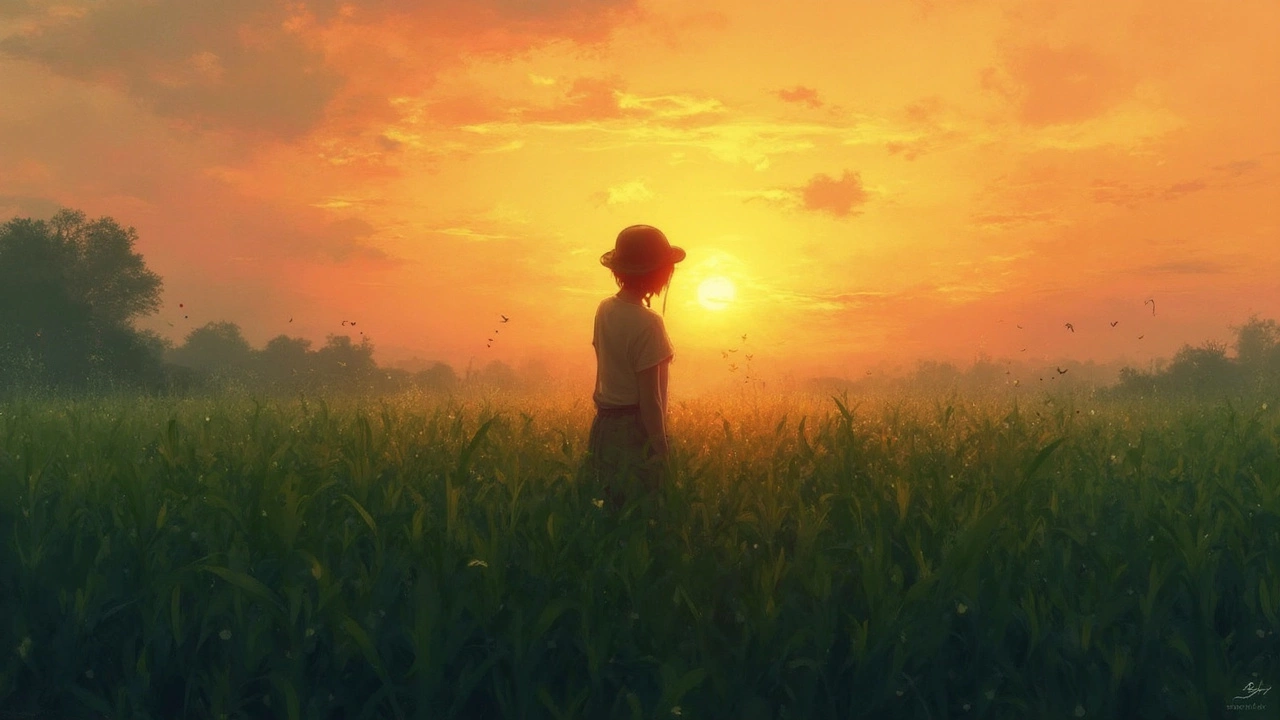Ever been caught wondering whether to greet someone first? It's like standing on the edge of a diving board, unsure if you want to plunge into the deep end. This seemingly simple act of saying 'hello' can be super complicated, especially when steeped in the rich tradition of Indian sad poetry. Here, a greeting isn’t just a word—it's a delicate dance of emotions, wrapped in cultural nuances and personal reflections.
Think about it: why does saying 'hi' feel so heavy at times? In the poetry of heartbreak, everything carries weight, from a silent glance to an uttered word. Sad poetry, particularly from India, captures this tension beautifully. It's where unspoken emotions find voice, where the smallest gesture is loaded with meaning and expectations.
Taking the first step to greet someone is often tangled with ego. You don’t want to seem overly eager, right? Or perhaps you worry they’ve moved on while you’re stuck in the past. This internal struggle is so common in the dynamics we see in sad poetry. But the question remains, should you break the silence first? Understanding this emotional seesaw can shed light on both personal interactions and the art of poetic sorrow.
- The Emotional Weight of Greetings
- Cultural Context in Indian Sad Poetry
- Ego and Expectation
- Understanding Unspoken Bonds
- Practical Tips for Greeting Dilemmas
- Reflections on Emotion and Verse
The Emotional Weight of Greetings
Why does such a simple gesture as a greeting carry so much emotional baggage? In the realm of sad poetry, especially in India, saying ‘hello’ can symbolize everything from acceptance to vulnerability. When set against the backdrop of poetic sorrow, these two little words can either bridge hearts or deepen silence. So, what’s the underlying story?
In everyday interactions, a greeting is often just a formality. But when emotions run high, this act becomes a subtle test of intentions and feelings. It’s like saying, “I’m opening a door—will you step through, or will you leave it ajar?” This is where culture makes its mark. In Indian contexts, where family and social ties knit the fabric of daily life, the weight of a greeting grows heavier. A greeting is a declaration: it’s not just a hello, but a gesture heavy with cultural significance.
Think about the classic poems that beautifully express this tension. In many stories and poems, a character’s decision to speak first is fraught with expectation and longing. They say action speaks louder than words—yet sometimes, a word is all that’s needed to act. That’s precisely the pull of a greeting in a poetic setting; it’s a decision, layered with hope and fear, wrapped up in tradition and expectation.
Now, put this in the frame of modern life, where everyone’s just a text away. Could sending that first text be similar to these poetic greetings of old? The principle remains the same: a small gesture can open or close doors, telling people how much you miss them or showing they no longer cross your mind.
Ultimately, greeting someone first is less about breaking silence and more about embracing vulnerability. It’s about setting ego aside and reaching out with sincerity. That’s why it’s such a common theme in sad poetry from India—it captures the delicate balance between heartache and hope, between the desire to connect and the fear of rejection.
Cultural Context in Indian Sad Poetry
Diving into sad poetry from India is like peeling back layers of emotions shaped by history, tradition, and society. It's more than mere words; it reflects the soul of a culture that's been crafting verses of yearning, loss, and love for centuries. Understanding this context can be a game-changer when you're wrestling with whether to greet someone first.
India has a long tradition of poetry that digs deep into emotions. From the passionate Ghazals of Urdu, which sing of unrequited love and missed chances, to the melancholic verses in Hindi literature, there's a rich tapestry to unravel. Poets like Mirza Ghalib and Faiz Ahmed Faiz remain iconic figures who capture the essence of longing and heartache. This literary background influences how emotions are expressed even today.
In Indian culture, greetings aren't just about politeness; they’re quite personal. Social hierarchies, respect for elders, and the nuances of personal relationships all play a role. This means that saying 'hello' isn't straightforward—it can carry expectations rooted deeply in the societal framework.
Sad poetry often echoes these cultural elements by providing a voice to emotions that can't be easily spoken aloud. In a poem, a simple line can reveal struggles with ego, pride, and the pain of waiting. It's this very layered approach that makes greeting someone a much more complex task than it seems. You might find that navigating this poetic and cultural landscape helps you understand your hesitations better.
In the end, the interaction between cultural norms and poetic expressions in India shapes how emotions are perceived and articulated. If you're stuck on whether to greet someone first, thinking about how these elements interact can offer insight. It’s like seeing yourself as part of a larger, timeless narrative where even the smallest actions echo through lines and stanzas crafted years ago.
Ego and Expectation
When it comes to reaching out first, ego often plays the role of an unwanted guest at the party. It's like a little voice in your ear daring you not to be the first to cave in. And in the world of sad poetry, especially within India's rich tapestry of emotions and stories, the stakes are real. Here, every action—or lack thereof—is underlined by centuries of cultural norms and personal pride.
Let's break it down. Ego isn't just about arrogance. It's about self-worth and the fear of being seen as overly eager or weak. It whispers, 'Let them come to you.' This sentiment is mirrored in countless verses where poets lament their own hesitation, caught in a tug-of-war between heart and pride.
Now, add expectations into the mix. Expectations from the other person, yes, but also societal expectations. In many cultures, not just India, who makes the first move can be loaded. It sometimes implies deeper feelings or intentions. So, you're not just dealing with your own feelings, but also considering what others might think or expect.
Here's where things can get practical. Navigating this involves balancing ego with honest communication:
- Ask yourself what matters more—your pride or the connection you share?
- Try to gauge the other person's mood and cues.
- Consider what you're comfortable with; there's no point in forcing yourself into a move that just doesn't feel right.
In this dance of egos and expectations, understanding both sides can help lessen the tension. It turns a seemingly small gesture of reaching out into an art form, something deeply rooted in human relationships and the poetic soul.

Understanding Unspoken Bonds
When it comes to sad poetry, unspoken bonds are like invisible threads that tie emotions together. These are the connections you feel but don't really talk about. Sound familiar? In Indian context, this is part of what makes this type of poetry feel so relatable.
Unspoken bonds often originate from shared experiences. These might be the heartaches and joys that two people go through together, even when words aren't exchanged. It’s this common history that makes you feel connected, even in silence. Sad poetry reflects these feelings beautifully, capturing the essence of emotions left unsaid.
Think about Indian sad poetry's iconic moments—many involve subtle exchanges, like a momentary glance or an unsaid understanding. Poets use these elements to create works that move us deeply, showing how powerful bonds can be conveyed without a single spoken word.
In poetry, and life too, these unspoken bonds show that not everything needs to be vocalized to be understood deeply. This is crucial when you're considering whether to greet someone first. Sometimes, it's the understanding built over time that guides you, not just the immediate feeling.
You might wonder how this connects to your dilemma of greeting first. Well, realizing the strength in your unspoken bond can guide your actions. If you feel that connection is strong enough, it may be worth taking that step to say 'hi' first, breaking the ice, and perhaps even rekindling a lost connection through a simple gesture.
Practical Tips for Greeting Dilemmas
Saying hello can be tricky, especially when emotions run deep, like in *sad poetry*. But hey, it's not all about feeling stuck. There are ways to tackle this. Here are some useful tips that might make your next greeting a bit easier.
- Gauge the Setting: Look around and feel out the environment. If you’re at a gathering or event, notice how relaxed or tense it feels. This can clue you in on whether a greeting might be welcome or awkward.
- Read the Room: Body language says a lot. Is the other person looking approachable, or are they avoiding eye contact? This can help you decide if it's the right time to say hi.
- Consider Your Intentions: Are you hoping to mend fences or simply be polite? Being clear about why you want to greet someone first can solidify your decision and make you feel more confident.
- Keep It Casual: Sometimes, a simple nod or smile can go a long way. There's no need to dive into a full conversation if you’re not ready.
- Respect Boundaries: If the other person seems uninterested or busy, don't push it. Respect their space just like you'd want them to respect yours.
- Reflect on Past Interactions: If you’ve had awkward encounters before, think about what went wrong and what you can do differently this time.
Greeting someone first can be nerve-wracking, but it doesn't have to feel like a burden. Whether you're inspired by *poetry* or real life, these tips could help you navigate emotional waters with a bit more ease. Remember, a little awareness and empathy go a long way.
Reflections on Emotion and Verse
Poetry, especially sad poetry, is often like a mirror reflecting deep, raw emotions that we sometimes can't express in everyday life. In India, the tradition of sad poetry has been around for ages, capturing the nuanced shades of heartache and longing. What's amazing is how it helps people connect with feelings that are hard to articulate. The act of reading a poem and feeling understood can be quite powerful.
The importance of emotion in poetry can't be overstated. According to a study by the University of Cambridge, engaging with poetry actively involves the same brain areas that process powerful emotions such as falling in love or grieving. That explains why certain lines can hit you straight in the feels.
"Poetry is when an emotion has found its thought and the thought has found words." — Robert Frost
This quote by Robert Frost hits home the idea that poetry isn't just words on a page. It's the emotion having been given a voice through carefully chosen words. In the rich tradition of Indian poetry, this is especially true. Even though sadness is a universal theme, the cultural perspectives make Indian sad poetry unique, blending elements of heritage, art, and personal experience.
- Emotion vs. Thought: Poets ponder endlessly how much of their work should be driven by feeling versus thought.
- Cultural Context: Every region has its distinct touch, but the emotions they express through poetry are universally relatable.
- Verses as Therapy: Many people find comfort in expressing feelings through poetry, a therapeutic activity that can make sense of chaos in the mind.
Sad poetry offers insight and understanding, connecting us with authors who've probably felt exactly the way we do. By reading or writing it, you enter a sort of dialogue with emotions, both your own and others'. And in a world brimming with chaos, who wouldn't appreciate that little bit of soul solace?
